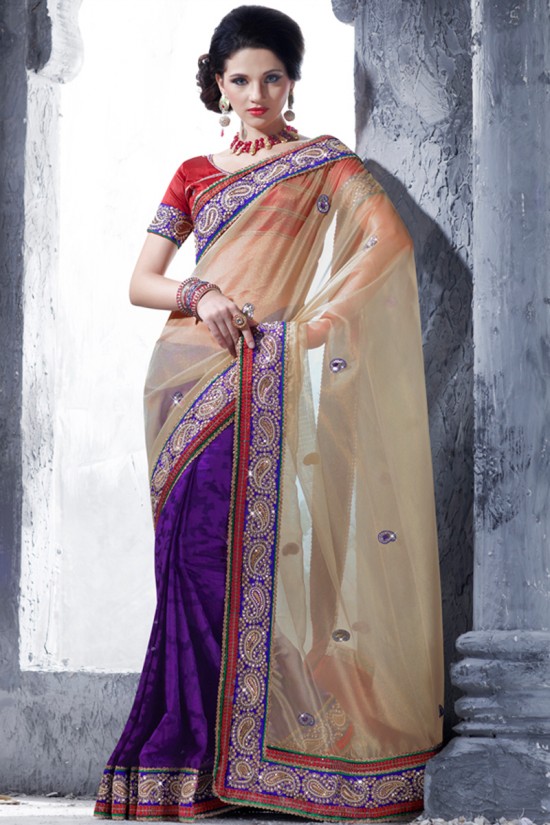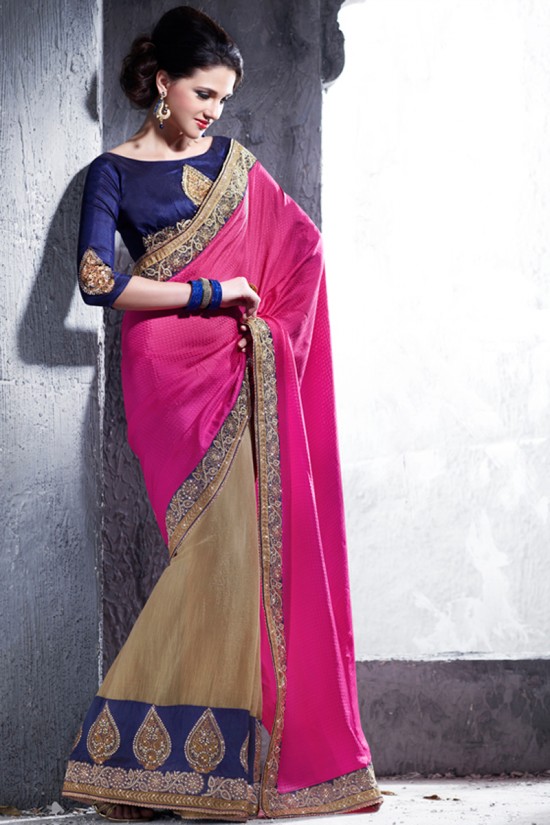Sarees Biography
Source (google.com.pk)The Sari in Pakistan did a disappearing act after it was declared un-Islamic by Zia. But the whole six yards has made a comeback in the form of formal wear as well as in the trousseaus of Pak girls. Therefore, Pakistan is seeing the resurgence of the Saris in a big way. Earlier the Sari was donned by prominent women like Fatima Jinnah, Begum Liaqat Ali and Nusrat Bhutto. However, later Gen Zia declared that saris implied an un-Islamic connotation and that’s when the Saris lost their grip on the Pakistani fashion and gradually started to fade away.
Today the strong revival of the Sari in Pakistan has lead to many women dressed in this attire. Many women consider it as a symbol of independence and individuality. Popular Indian soaps have essentially contributed to the revival of the sari. The intricate and ornate saris are a favorite as a bridal wear. The tall and stately Nusrat Bhutto was one of the first ladies of Pakistan to wield power. She was usually seen in exquisite silk saris accessorized by pearl necklaces. However, her daughter Benazir Bhutto preferred the salwar kameez over the sari. She would team this up with a green jacket and a white chiffon dupatta, pinned properly to her head. This was more of an expression of nationalism than making a fashion statement.
The sari is a “softer” image of Pakistan that reveals too much of a woman’s body for an Islamic republic. No Pakistani woman parliamentarian today goes to the assembly in a sari. However, the fashion conscious Pakistani women are boldly donning the elegant attire, enough to make a splash and stir up and vex the zealots. Finally the mid riff baring attire has found its way back on the Pakistani soil. However, the salwar kameez still reigns supreme and is widely preferred over the sari. Nonetheless, the sari is not imperiled to become defunct.
The sari is not only worn by the Parsis and Hindus but also by women from (non-Punjabi) Urdu-speaking families. “My mother still doesn’t own a formal salwar kameez,” says Amna Jamot, who belongs to a family of middle-class Urdu-speaking migrants. “She wore only saris and it comes naturally to her generation.” Quite often at the age of 18, Pakistani girls are allowed to wear a sari to their graduation party, Pakistan’s fashion equivalent of prom night. The sari lends them the ultimate feel of womanhood, independence and elegance. It’s also become an expression of freedom and rebellion for celebrities like Ali Saleem, Pakistan’s most famous cross-dresser. Begum Nawazish Ali hosts a popular talk show on AAJ TV. Ali wears exquisite designer saris which are quite exotic and intricately embellished. In fact Ali’s ultimate fantasy is to “die performing on a glass stage in the middle of a vast sea with the whole world watching”!
However wearing a sari gathers one a lot of attention and many members of the Hindu minority living in Karachi have experienced this feeling. Moreover, the sari has become an almost indispensable piece of attire especially on special occasions like weddings and festivals. “I’ve always worn the sari,” says Ira Bai, a Hindu housemaid working in the city’s posh Bath Island. “But my daughter now wears the salwar kameez. She lives in Hyderabad and commutes a lot between cities. Wearing the sari attracts too much unwanted attention.”
Pakistan’s trendiest fashion designer, Deepak Perwani, belongs to a Hindu household but confesses a disinterest in reviving saris in Pakistan. He however prefers to create trendy fashionable clothing for the fashion conscious elite.
“I design for the young, and the young in Pakistan don’t wear saris,” he says. Out of every 100 clients only seven or eight will go for one, he adds. “It’s an extremely elegant garment and the salwar kameez can never replace that elegance and style, but the sari belongs to the gentry of Pakistan or the older generation. The old aunties still wear saris but it’s just not practical for the modern woman.” However, when it comes to his bride he would prefer her to be attired in the whole six yards when he decides to take the plunge.
According to Pakistan’s ace bridal couturiers Umar Sayeed the revival of the sari is seen in Pakistan largely contributed by the demand of formal and bridal wear. According to him, it’s the increasing demand for saris for weddings that allows sari-manufacturing areas like Karachi’s Orangi Town to prosper.
“Someone must be buying these saris for the production to be on a constant high,” he says. “As a designer I see a 1:3 ratio (of saris to salwar kameezes) and brides from all over Pakistan are coming to us for saris to wear to their Valimas (a traditional dinner hosted by the groom’s parents one day after the main wedding ceremony). The demand for bridal saris is increasing. They are timeless and people realize the worth of investing in them.”
The chairperson of Fashion Pakistan, one of Pakistan’s fashion councils, Maheen Khan has altered the style of the sari in a bid to modernize the attire. She has created the ‘half-sari’, a two piece combination that tucks a separate dupatta into a folded petticoat. Pakistani designer saris are made of delicate chiffon fabric and usually intricately embellished. These come at a price tag of at least Rs.50, 000 Pakistani rupees.
Younger generations prefer saris in simple chiffons or light silks teamed with a stylish sleeveless blouse. As far as cotton saris go, India is the best place to look for quality and genuineness. Designer saris are best preferred for formal wear.
Sarees Sherwani Designs 2014 For Groom By Manish Malhotra By Amir Adnan By Junaib Jamshed By Deepak Perwani Photos

Sarees Sherwani Designs 2014 For Groom By Manish Malhotra By Amir Adnan By Junaib Jamshed By Deepak Perwani Photos

Sarees Sherwani Designs 2014 For Groom By Manish Malhotra By Amir Adnan By Junaib Jamshed By Deepak Perwani Photos

Sarees Sherwani Designs 2014 For Groom By Manish Malhotra By Amir Adnan By Junaib Jamshed By Deepak Perwani Photos

Sarees Sherwani Designs 2014 For Groom By Manish Malhotra By Amir Adnan By Junaib Jamshed By Deepak Perwani Photos

Sarees Sherwani Designs 2014 For Groom By Manish Malhotra By Amir Adnan By Junaib Jamshed By Deepak Perwani Photos

Sarees Sherwani Designs 2014 For Groom By Manish Malhotra By Amir Adnan By Junaib Jamshed By Deepak Perwani Photos

Sarees Sherwani Designs 2014 For Groom By Manish Malhotra By Amir Adnan By Junaib Jamshed By Deepak Perwani Photos

Sarees Sherwani Designs 2014 For Groom By Manish Malhotra By Amir Adnan By Junaib Jamshed By Deepak Perwani Photos


No comments:
Post a Comment